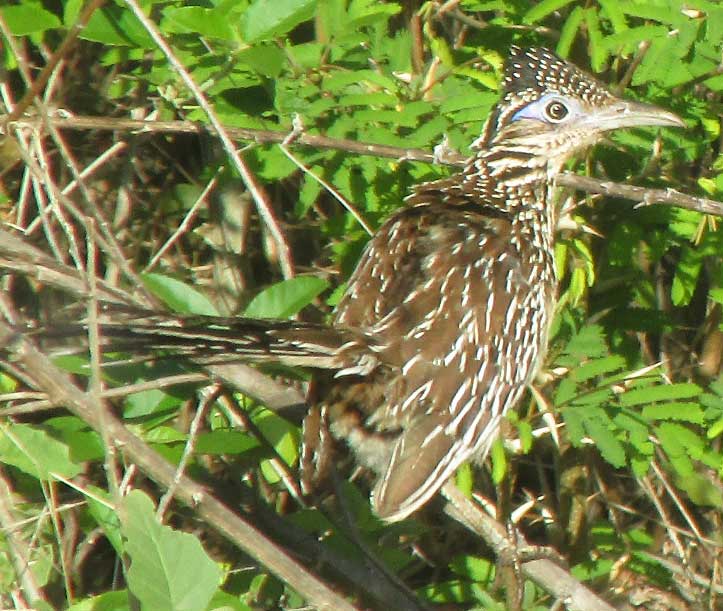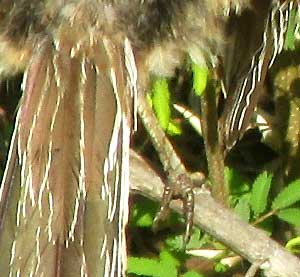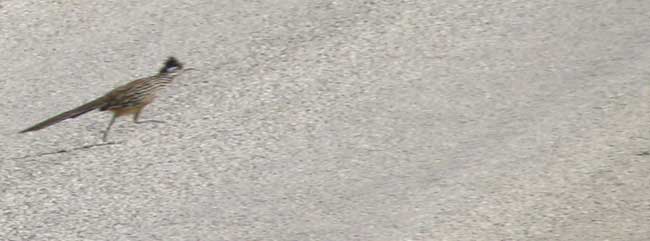Excerpts from Jim Conrad's
Naturalist Newsletter
issued May 18, 2020 from Tepakán, Yucatán, MÉXICO
SUN-BASKING ROADRUNNER
For three or four months a roadrunner has taken up residence along the rancho's entrance trail, near the hut, and likes to bask in early-morning sunlight, as shown below, with back feathers fluffed.

Below, the above bird has turned sideways:

 Roadrunners belong to the Cuckoo Family, a curious feature of which is that the species have "zygodactyl" feet -- each foot's two outer toes point backward, the two middle ones forward -- same as with woodpeckers, parrots and owls. At the right you can see the outer two toes pointing backward.
Roadrunners belong to the Cuckoo Family, a curious feature of which is that the species have "zygodactyl" feet -- each foot's two outer toes point backward, the two middle ones forward -- same as with woodpeckers, parrots and owls. At the right you can see the outer two toes pointing backward.
In the past it was hard to get pictures of this species, but the one at the hut has grown used to me.
from the November 21, 2010 Newsletter issued from Hacienda Chichen Resort beside Chichén Itzá Ruins, central Yucatán, MÉXICO
ROADRUNNER RUNNING
Roadrunners are fairly common here, but I never thought I'd get a picture of one, since nearly always you see them only as they dart across the road. By the time you realize you're seeing a roadrunner, it's gone.
Last Sunday as I biked south of Pisté one streaked across the road before me but, as usual, by the time I'd stopped and gotten the camera out, he'd long since vanished into roadside grass. Though I readied the camera and waited for him to reappear, I kept thinking that it wasn't worth it. For, this was a game they'd been playing with me for years, as if really they were consciously teasing me with their sudden appearances followed by their inevitable disappearances.
I was about to put the camera away when a car began approaching from the other side. "If they really do enjoy crossing roads right in front of oncoming travelers, maybe this one will cross before this car," I thought to myself. As the car came into view I readied the camera, then when the car was the same distance from him as I'd been, he zipped across the road, I snapped, and got the movement-blurred image shown below.

This is the Lesser Roadrunner, GEOCOCCYX VELOX, different from the Greater Roadrunner, Geococcyx californianus, of the southwestern US, who not only is larger but also has a more heavily striped throat and chest. The Lesser occurs only along the Mexican Pacific coast south to Nicaragua, plus there's a disjunct "island" population restricted to northwestern Yucatan.
So, do roadrunners really like to cross roads in front of other road users? I can't imagine how it would benefit the bird, except maybe to keep its reflexes sharp, or to appeal to some sense of fun it may have.

from the December 5, 2010 Newsletter issued from Hacienda Chichen Resort beside Chichén Itzá Ruins, central Yucatán, MÉXICO
ROADRUNNER RERUN
This week I was biking that part of the road south of Pisté where two weeks earlier a roadrunner had appeared. Even though I wasn't expecting to see anything I scanned the scrubby forest understory as I passed by, hoping for a better shot. Then there was movement. I stopped, got the camera ready, and after about ten minutes more movement occurred atop a roadcut down the road. Slowly I brought the camera around, auto-focused where I thought he might be, and got lucky when he stepped right into view. That's him above.
from the March 10, 2008 Newsletter issued from Mexico's Southernmost State, CHIAPAS
ROADRUNNER FORAGING FOR LIZARDS
When you watch a roadrunner foraging for lizards you think, "He's behaving just like an American Robin looking for earthworms in a suburban mowed lawn..."
The big, lanky bird runs fast for a couple of seconds, stops five or six seconds with his head held high and an intense look on his face, then runs for another couple of seconds, stops once more looking hard at the ground before him, and on and on. It's something how such unrelated, physically dissimilar birds can end up acting the very same.
In the US's arid Southwest there's just one roadrunner species, simply called Roadrunner in many field guides. It's Geococcyx californianus, and it extends south into central Mexico. Here farther south we have a second species, Geococcyx velox. The northern one is larger, up to 24 inches long (61 cm), and is often referred to as the Greater Roadrunner, while our smaller southern species, growing to only 20 inches (50.5 cm), is the Lesser.
It's typical that all you see of a roadrunner is a blur when he darts across the road before you, looking almost as much like a big lizard as a bird. If you're lucky enough to see one foraging you have to admire the bird's alertness, streamline form, cocky crest and the bold, dark-brown streaking on a pale tan body. The ones I'm seeing here show much more intense pale blue spots behind the eyes than is shown in the field guides.
Sometimes you hear roadrunners more than see them. Both species make a slowing-down, descending series of 3-7 low, moaning coos, ooooah, ooooah, ooooah... almost dove-like, but louder.
If all you know of cuckoos is the North's Black-billed and Yellow-billed Cuckoos, you might be surprised that roadrunners are full-fledged members of the Cuckoo Family, the Cuculidae. However, if you're familiar with our anis, which also are members of the Cuckoo Family, you know that the family is a diverse looking one.
A traveling salesman on a bus once told me about a fellow who put some roadrunner eggs beneath his old hen. The baby roadrunner grew up behaving just like a chicken, until the day he ran off.